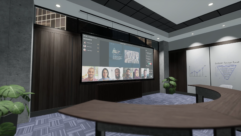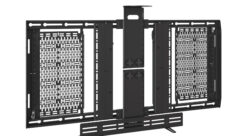
Line Out: Videoconferencing: Now What?
Mar 1, 2004 12:00 PM,
By Stephen Villoria
As visual communication continues to grow as a dominant form of doing business, it’s important that we examine how far we’ve come and ascertain where we’re going. Integrators, designers, installers, and vendors must grasp that the nature of communication has changed, and therefore the old concept of videoconferencing no longer accomplishes what it was intended to do. A new age of media conferencing is already upon us, and as professionals in this industry, we must embrace the changes and move forward.
When first conceived, the idea of videoconferencing was a step forward, because workers in distant offices could at least see who was on the other end of the conversation. Yet the novelty quickly wore off as it became obvious that there were serious limitations to talking video heads.
That system was really an example of miscommunication, because you could see the person but could not incorporate anything else into a presentation. This fundamentally excluded the way that people actually communicate with each other. When people are in the same room, they show each other written notes, drawings, photos, printouts — any number of visual media to get their point across. Without these things, there is always a perceived inadequacy to the proceedings.
To fill this void, media conferencing has arrived. This concept includes a breadth of technologies, all brought together through a single communications platform that emulates how people communicate and share ideas together. Such a system must include multiple devices that offer multiple media forms and are, more than likely, spread over several locations. Also, a media-conferencing system must incorporate features such as interactivity. One example of this is a system that lets all parties annotate presented data from any location without restrictions.
That is possible through a standardized platform that brings together all the incompatible media formats into a common digital environment. The system can incorporate in a single presentation various video feeds and multiple data types, up to and including computer programs or files, paper documents, and even a white board. To do this, a standardized media-conferencing system allows free and open use of these data types without restricting the user with different and incompatible formats. One unifying platform brings it all together. In addition, there must be the ability to record, archive, and retrieve any part of a presentation or meeting anywhere, at any time.
This is where we are now, and the future will require the power and flexibility of an open system that can incorporate whatever presenters want to bring to their presentations. For integrators, what does that mean? It means better business.
With a unified platform serving as the central hub in this communication wheel, integrators will enjoy faster, easier, and more troublefree integration with a better performing system. How many times have you seen an old-style videoconferencing system installed just to have customers complain that it’s not what they thought it would be? It’s not the integrator’s fault that the system’s capabilities were oversold. That won’t happen with a media-conferencing system.
Media conferencing also means better margins for integrators, which stems from the unifying nature of standardization. The client can choose to incorporate anything he or she wants, and the integrator can quickly implement the request without it eating into his or her profits. A standardized platform means design and installation is quick, simple, and profitable.
Starting now the new media-conferencing system will need to be able to capture a meeting, broadcast a presentation throughout a network, and deliver streaming Webcasts even when someone can’t be there to run the system. You will want it to automatically switch between camera shots of individuals and wide shots of group discussions, as well as incorporate the media they are displaying. Various remote offices or private suppliers will want to monitor meetings in progress over CCTV, over a network on a computer, or even stream the information to a common server. These capabilities are here now if we embrace the concept of standardization and move to a brighter, more open future.
Stephen Villoriais president and CEO of Advanced Media Design.
“Line Out” is the forum forSound & Video Contractorreaders to speak out about industry-related topics from trends to business practices to technology. Contact Mark Johnson at (510) 985-3203 or at[email protected]to voice your opinion.










